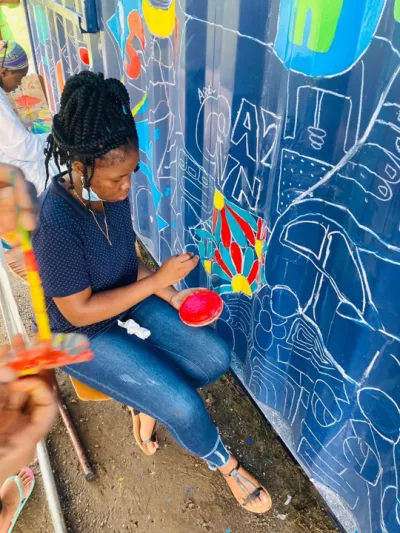General information
RDP Priority
- P6. Social inclusion and local development
RDP Focus Area
- 6B: Local development
RDP Measure
- M19: LEADER/CLLD
Beneficiary type
- Local association
Summary
The Contain’Art project aims to improve access to art and digital tools for the citizens of French Guiana through the organisation of activities, trainings, and workshops for a broad spectrum of the public, including students, artists and craftsmen. The project positions art and digital tools as the drivers of local development for the territory, and enables participants to get new skills which they can reuse in their personal and professional lives.
Results
- The investment phase successfully resulted in the creation of the fab lab space, where the art and digital workshops and activities could be hosted.
- The implementation phase has so far achieved:
- The participation of 150 local inhabitants, including many students, in the project launch event;
- The organisation of a five-day artist residency attended by seven high school students;
- The organisation of 12 art workshops and 12 digital workshops;
- The project’s acquisition of the “Micro-folie” label, which connects it to an even wider network of digital culture initiatives.

Promoter
Maisons des lycéens du Lycée Léopold Elfort
Funding
RDP contribution: 98 414 (EUR)
EAFRD: 37 379 (EUR)
National/Regional: 61 035 (EUR)
Ressources
Context
The Contain’Art project is part of a territorial initiative promoting culture and heritage which started in 2018 and was titled “Semeurs d’art” (“Sowers of Art”). It aims to make art a driver of local development, employment and opportunities. The Contain’Art project is funded by LEADER and is led by the “Maison des Lycéens” association (high school students association) from the Léopold Elfort High School (Mana, French Guiana). The northwest of French Guiana has almost 70 000 inhabitants, and is a rural territory that suffers from isolation and a lack of access to digital skills training.
Before Contain’Art, the project promoter organised several events during a local ‘Art Week’ festival - also funded by LEADER - which consisted of workshops and activities for high school students concerning cultural heritage, arts, crafts, and digital tools. About 14 to 16 workshops were organised for each edition of that festival until 2020. Since then, the event has been developed throughout the wider territory of French Guiana.
Emerging from the “Semeurs d’art” initiative, the Contain’Art project was about establishing permanent infrastructure and a programme that would support greater participation in creative and cultural activities in northwest French Guiana, and also offer training in these fields to students and professionals. The Contain’Art project was implemented in two main steps: the investment phase (2020-2022), and the activities implementation phase (2023-2025).
Objectives
The aims of this project were to:
- Contribute to the local economy and cultural development of an isolated territory.
- Improve public access to digital tools and improve access to art through the use of digital tools.
- Increase the digital skills of the local population (image, sound, video, 3D prints, virtual reality, robotics).
Activities
Activities during the investment phase – 1st LEADER-funded project (2020-2022):
- purchasing a container to set up the fab lab, including an outdoor tented area.
- purchasing digital and technical equipment to provide training in image processing; sound and video; 'photogrammetry'; augmented reality; virtual reality; 3D modelling; robotics; and programming.
Activities implemented during the implementation phase – 2nd LEADER project (2023-2025):
- creating pedagogical factsheets and open-sourced material. Each artistic and digital activity leads to the production of a deliverable (e.g. factsheet, video, interview) explaining the activity and how it can be replicated.
- developing an open badge system to validate the skills acquired by participants during the project’s implementation.
The target audiences for the programme of activities - e.g. the artist residencies, digital mediation, workshops and trainings – are artists, craftsmen and students.
Main results
Results of the investment phase include:
- The creation of the fab lab (a fully equipped container and outdoor space) for hosting art and digital workshops and activities.
Results of the second phase include:
- The participation of 150 local inhabitants, including many students, in the project launch event;
- The organisation of a five-day artist residency attended by seven high school students (expected to increase to at least 170 students in the future);
- The organisation of 12 art workshops and 12 digital workshops;
- The project’s acquisition of the “Micro-folie” label, which connects it to an even wider network of digital cultural heritage through the integration of a ‘digital museum’ into the activities offered at the container.
Key lessons
- In order to successfully implement this kind of project, a varied team of specialist facilitators are needed who can properly ‘animate’ the fab lab and deliver the programme of activities as planned. Working with freelance artists, craftspeople and creatives relies upon forward planning and booking to ensure their availability. Delays in project implementation can result in the loss of access to specialist creative skills. It is very important, therefore, that the task of hiring and coordinating human resources is undertaken as soon as the financial resources have been secured.
The idea behind this project was to combine two key components: art, in which our students and inhabitants are very interested, and digital, which is inevitable nowadays and can lead to new creations.
